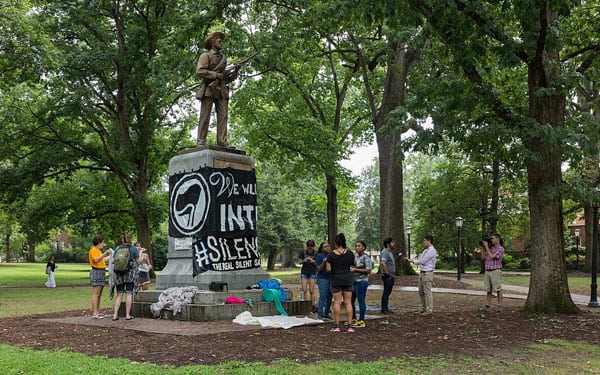
August 21, 2018; Washington Post
Silent Sam is a monument found on the campus of one of the nation’s claimants to the title of oldest public university, the University of North Carolina at Chapel Hill (UNC). The statue of a Confederate soldier was given to the school from the North Carolina division of the Daughters of the Confederacy in 1913, nearly 50 years following the end of the Civil War and less than two decades after the Supreme Court decision of upholding “separate by equal” (Plessy v. Fergusson) had help consolidate “Jim Crow” laws in the South. The invited speaker at the unveiling of the monument, Julian Carr, was an alumnus of UNC, but also a prominent industrialist and supporter of the Ku Klux Klan. Carr made clear what the statue symbolized through a personal story in his lengthy unveiling address:
One hundred yards from where we stand, less than 90 days perhaps after my return from Appomattox, I horse-whipped a negro wench until her skirts hung in shreds, because upon the streets of this quiet village she had publicly insulted and maligned a Southern lady, and then rushed for protection to these University buildings where was stationed a garrison of 100 Federal soldiers. I performed the pleasing duty in the immediate presence of the entire garrison, and for thirty nights afterwards slept with a double-barrel shot gun under my head.
On Monday, the day before classes began, Silent Sam was torn down by protesters on UNC campus. Student activists and many others have long called for the removal of Silent Sam due to what it symbolizes—and in some ways endorses. Earlier this year, Maya Little, an African American graduate student at UNC, doused the statue with a mix of ink and her own blood “because it sits sanitized, and yet it’s founded on this idea of violence towards black people.”
Sign up for our free newsletters
Subscribe to NPQ's newsletters to have our top stories delivered directly to your inbox.
By signing up, you agree to our privacy policy and terms of use, and to receive messages from NPQ and our partners.
Silent Sam has been at the center of controversy since the 1960s during the Civil Rights movement and it was first vandalized the day after Dr. Martin Luther King Jr. was assassinated in 1968. Efforts by civil rights groups and others to do away with Confederate monuments like Silent Sam gained momentum three years ago after Dylann Roof murdered nine black people at a church in Charleston, South Carolina. As Jonathan Drake reports for Reuters, “The shooting rampage ultimately led to the removal of a Confederate flag from the statehouse in Columbia, and now more than 110 symbols of the Confederacy have been removed across the nation with more than 1,700 still standing.”
So, with all the controversy and the expressed concern and discomfort of UNC students, why didn’t the UNC administration act? Last August, North Carolina Governor Roy Cooper told university officials that the statue could be removed if they believed that “there is a real risk to public safety,” but UNC chose not to because they believed that “removing the statue would violate a 2015 law that forbids taking down public monuments without the approval of the North Carolina Historical Commission.”
On Monday night, University Chancellor Carol Folt wrote an open letter denouncing the vandalism that took place but acknowledging the controversy the monument has always caused, stating, “The monument has been divisive for years, and its presence has been a source of frustration for many people not only on our campus but throughout the community.” She continues, “However, last night’s actions were unlawful and dangerous, and we are very fortunate that no one was injured. The police are investigating the vandalism and assessing the full extent of the damage.”
For years, the community and the students at UNC have cried out their disdain for the statue, yet nothing has been done. Monday’s incident symbolizes a desire to be heard and understood by those who protested.—Diandria Barber













